Just outside greater Mexico City, the ruins of Teotihuacan are a place of massive pyramids and profound mystery.
The ancient city is so old that the Aztecs, the dominant group in the Valley of Mexico at the time of the arrival of the Spanish, didn’t even know who built it.
Today, there’s much speculation about the origins of Teotihuacan, although not many facts. Archeological research is ongoing, with new tunnels and chambers still being discovered and explored.
I was fortunate enough to visit Teotihuacan several times during the many years I lived in Mexico.
I’ve taken public transportation from Mexico City to get there, and I’ve driven on my own. I’ve taken friends who were visiting Mexico for the first time, and I’ve gone all by myself. Each visit was an unforgettable experience.
Visiting Teotihuacan is one of the top day trips from Mexico City and one of the best things to see in Mexico. Don’t miss it.
Learn everything you need to know about visiting the Teotihuacan Ruins in this guide.
Teotihuacan Ruins Facts and History
As mentioned, it’s unclear which culture founded Teotihuacan and constructed its immense pyramids and temples. The two most likely groups are the Toltecs and the Totonacs.
The Toltecs were from central Mexico, and they’re best known today for their improbably huge statues and head carvings, which can be seen at archeological sites such as Tula.
Their peak came between that of Teotihuacan and the rise of the Aztecs, and they exerted a deep influence on many Mesoamerican cultures.
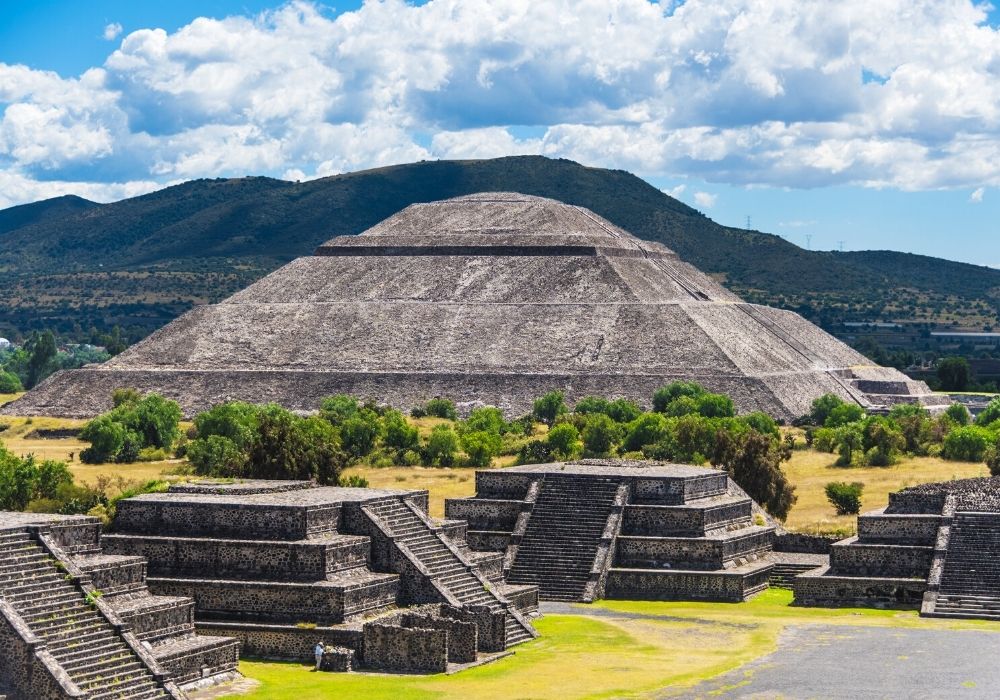
The Totonacs are from what is the state of Veracruz today. The people still exist, and part of their belief system is that their ancestors were the ones responsible for building Teotihuacan.
Evidence does show, however, that Teotihuacan was home to several cultures from various parts of pre-Hispanic Mexico, including the Toltecs, Totonacs, Mayans, Mixtecs, and Zapotecs.
Compounding the mystery of its origin is the mystery of its language. The residents of Teotihuacan had a written language, but researchers haven’t yet deciphered it.
Consequently, the original name of the city also isn’t known. Teotihuacan is a Nahuatl word that means “the place where men become gods.” It was given by the Aztecs, who arrived in the Valley of Mexico around 1250 CE, centuries after the demise of Teotihuacan.
Teotihuacan was probably settled as early as 400 BC. The peak of the city, when it was home to more than 100,000 people, was from 100 BC to 650 CE. The city covered 8 square miles and was the largest city in the Western Hemisphere.
The long collapse and abandonment of the city came next. One theory is that a brutal class war occurred between the city’s powerful elite and the much more numerous poorer classes.
Supporting this theory is evidence of a large fire that happened around 550 CE. Whatever the reasons for its decline, Teotihuacan was fully abandoned by 750 CE.
Teotihuacan Pyramids and Temples to Visit
Here’s a breakdown of the most important temples to visit at Teotihuacan.
Pyramid of the Sun and Pyramid of the Moon
The two most significant structures are the Pyramid of the Sun and the Pyramid of the Moon, which are also known as the Temple of the Sun and the Temple of the Moon.
The Pyramid of the Sun is the biggest structure at the ruins of Teotihuacan. At 213 feet tall, it’s the third-highest pyramid in the world, a little more than half as tall as the Great Pyramid at Giza, Egypt.
The Pyramid of the Sun is actually six pyramids, each one built over the other. And underneath it all is a cave.
Running in front of the Pyramid of the Sun is the Street of the Dead (Calle de los Muertos). This broad thoroughfare goes from the Pyramid of the Moon on its north end to the Ciudadela complex on the south end, near the main entrance to the park.
On the way, the Street of the Dead passes many ceremonial platforms that house intricate murals and carvings. When Teotihuacan was an active city, the road was 40 meters wide and 4 kilometers long.
At the far end of the Street of the Dead, the 147-foot-tall Pyramid of the Moon is the second largest structure at the archeological site. It was a place of human and animal sacrifices.
An excavation of the pyramid uncovered 12 human bodies, 10 of which were decapitated, along with a menagerie of wild animal corpses that included jungle cats and eagles.
Palace of Quetzalpapálotl
The Palace of Quetzalpapálotl is the most significant structure in the plaza before the Pyramid of the Moon. The detailed carvings inside its inner courtyard shouldn’t be missed.
Tepantitla Palace
East of the Pyramid of the Moon, the Tepantitla Palace is a little out of the way from the Street of the Dead. It has some of the most impressive murals at the entire archeological site.
La Ciudadela
Opposite the Pyramid of the Moon on the Street of the Dead, La Ciudadela (the Citadel, or ceremonial plaza) is an expansive courtyard that contains the Temple of Quetzalcoatl.
Quetzalcoatl was the Feathered Serpent and an important god to most Mesoamerican cultures. His temple is decorated with large carvings of toothy snake heads with slithering bodies, along with images of marine life, such as clams and conch shells.
Things to Do at the Teotihuacan Ruins
Climbing the pyramids is one of the best things to do when you’re visiting Teotihuacan. Normally, you can go all the way to the top to the tallest, the Pyramid of the Sun, and to a platform about halfway up the second tallest, the Pyramid of the Moon.
You can also climb and enter many of the other temples and ceremonial plazas. Some of them contain well-restored murals or lurid carvings. Rules can change, so make sure to check and see if you’re allowed to climb the pyramids before doing so.
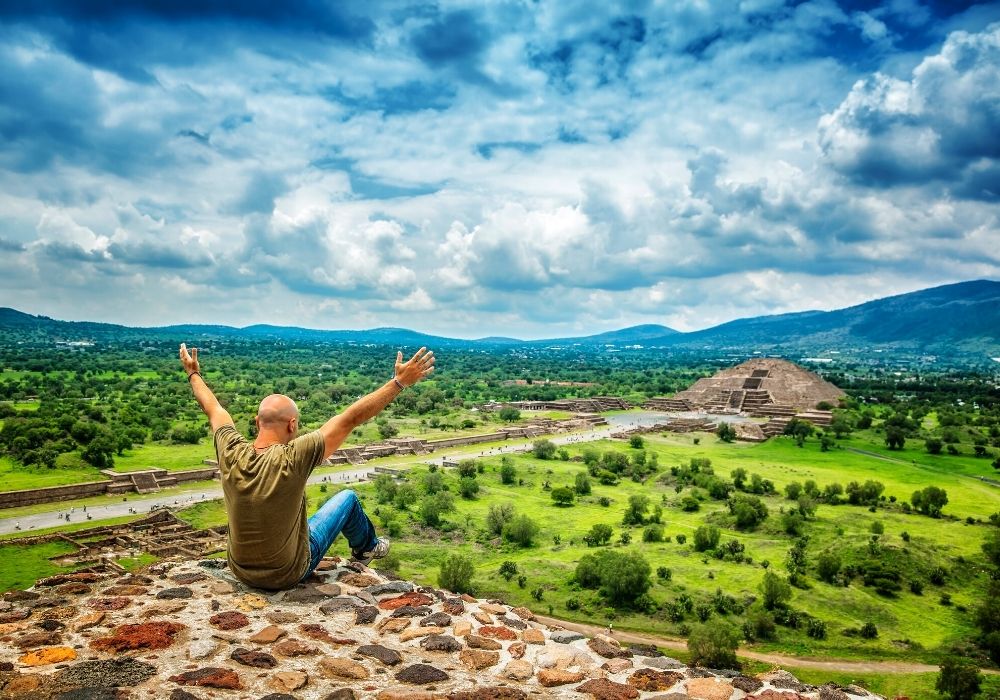
There are two museums at the ruins of Teotihuacan, and entry to both is included with your ticket.
The Museum of Teotihuacan Murals, near Gate 3A, has fragments of different types of ancient murals, which is a distinctive Mexican art form that continues to be practiced to the present day.
The Museum of Teotihuacan Culture, close to Gate 5, has permanent exhibitions of artifacts from the ancient city and information about current archeological research. The museum also has a sculpture garden and a botanical garden.
A popular activity is to fly over the Teotihuacan ruins in a hot air balloon. Check the section below about Teotihuacan tours for more information.
You can experience the Teotihuacan ruins after dark with the Experiencia Nocturna en Teotihuacán (Nocturnal Experience in Teotihuacan) show, which begins with a guided tour of the park and continues with a light and sound show.
Unlike the ruins themselves, you need to buy advance tickets for the light show through Ticketmaster. You can buy tickets from the Ticketmaster webpage and then pick them up at a Ticketmaster outlet in Mexico City.
The Teotihuacan ruins (and the town of Teotihuacan) are the occasional site of music festivals, such as the Festival Música para los Dioses (Music for the Gods Festival), a rock festival that included camping. It’s unclear whether this festival will continue to be held. Check the Facebook page for more information.
The town of San Juan Teotihuacan celebrates several yearly festivals. The most important is the birthday of John the Baptist, the patron saint of the town, which takes place in late June.
This is a good time to spend the night in a local hotel to experience a real small-town Mexican festival. There will be food, music, drinking, dancing, and lots of fireworks.
Of course, visiting Teotihuacan is a good way to work up an appetite. Fortunately, the Teotihuacan ruins are surrounded by restaurants that serve representative local food.
The best and most interesting is La Gruta Restaurant. It’s inside a large cave of volcanic origin. It’s somewhat on the expensive side, but the food is outstanding and regular folk dance shows are put on. La Gruta has had many famous diners, even Queen Elizabeth II.
Located opposite the park from the main entrance (and the parking lot), La Gruta is a 10 minute drive or 30 minute walk from there. It’s much closer to Gate 4 (near the Tepantitla Palace), so if you plan on going, leave the park from that exit.
Best Teotihuacan Tours from Mexico City
You can find many tours for visiting Teotihuacan, such as ones that leave early and skip the line. Others include liquor tastings, trips in hot air balloons, and stops at other Mexico City attractions.
From Mexico City: Teotihuacan Early Access & Liquor Tasting
This Teotihuacan tour gets you to the ruins early in the morning and skips the line. It includes lunch and a stop for tasting the representative Mexican liquors tequila, mezcal, and pulque.
Hot Air Balloon Flight over Teotihuacan, from Mexico City
On this Teotihuacan tour, you’ll spend 45 minutes in a hot air balloon flying over the archeological zone. The total time is five hours, and it includes breakfast and transportation from Mexico City.
Teotihuacan, Tlatelolco, Guadalupe Shrine and Tequila Tasting Tour
This tour combines a trip to the ruins with two other famous attractions in Mexico City.
The ruins of Tlatelolco, located in the Plaza of Three Cultures (pre-Hispanic, Spanish colonial, and modern Mexico), was the final refuge of the Aztecs during the Spanish conquest. The Guadalupe Shrine contains the original Virgin of Guadalupe painting and is one of the most important Catholic sites in Mexico.
5 Top Tips for Visiting Teotihuacan
The most important tip for visiting Teotihuacan is to go early. If you’re doing it on your own, allow at least three hours for taking the metro to the bus station, buying tickets, riding the bus, and finally buying tickets for the ruins.
Getting there early will not only beat the crowds, but you can also climb the pyramids before it gets too hot.
There’s hardly any shade at the Teotihuacan ruins, so bring protection from the sun. Be sure to wear good shoes for climbing. Flip flops may keep your feet cool, but they’re not very sturdy on rugged stones.
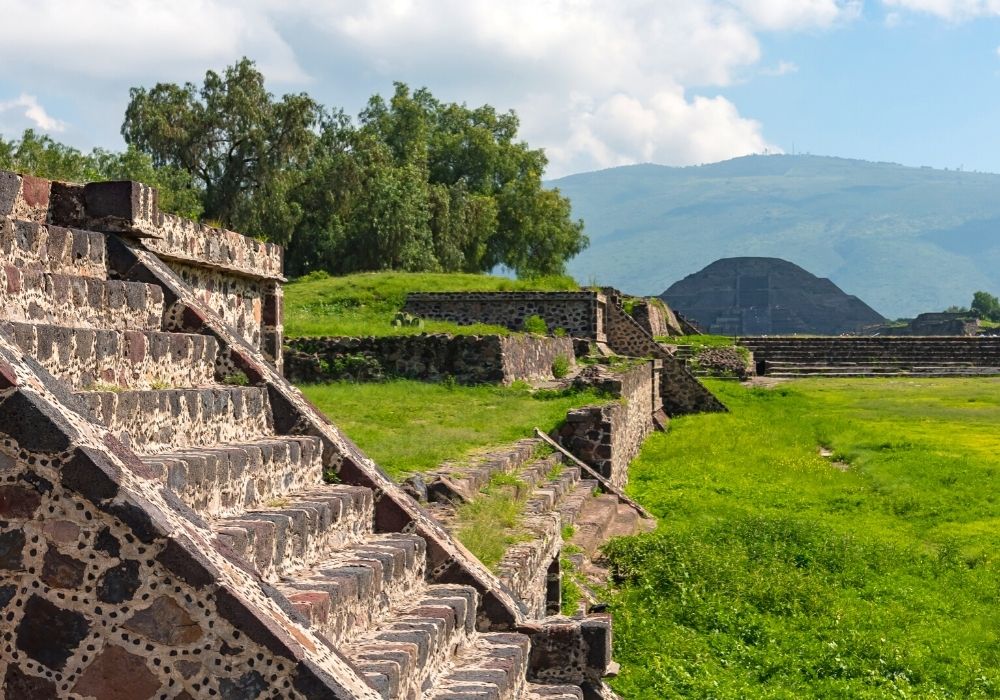
Teotihuacan is full of vendors selling all kinds of souvenirs of varying degrees of tackiness. You’ll surely get tired of hearing the loud jaguar call the vendor’s blow every few minutes.
A smile, a quick shake of the head, and a firm “gracias” (“thanks,” which also means “no thanks”) is the best way to deal with them. Please don’t be rude — they’re only trying to make a living — but you shouldn’t apologize or express interest, or one may follow you around for a while, being a nuisance.
You should make time to visit the museums, which are somewhat easy to miss off of the Street of the Dead. They have interesting exhibits and informative explanations, along with air conditioning, which you may find more beneficial.
Finally, I highly recommend eating at La Gruta. It has a wonderful setting and the food is excellent, with outstanding versions of traditional dishes. They have good margaritas too.
Remember to keep an eye on your watch if you’ll be taking the bus back to Mexico City. You don’t want to miss the last one. It can be hard to keep track of time when you’re eating tacos and sipping tequila in a cave.
Planning on visiting other ruins in Mexico? See these related articles:
- How To Visit The Tulum Ruins
- Visting Chichen Itza: A Guide to the Ruins
- 10 Best Mayan Ruins and Archaeological Sites in Mexico
Frequently Asked Questions
Below are some answers to frequently asked questions about visiting Teotihuacan.
Where Are the Teotihuacan Ruins?
The Teotihuacan ruins are 25 miles (40 kilometers) northeast of Mexico City. They’re located in the State of Mexico in the town of San Juan Teotihuacan.
How to Get to Teotihuacan from Mexico City
Frequent buses depart from Mexico City’s North Bus Terminal and go directly to the archeological site. The metro station at the terminal is called Autobuses del Norte, and it’s on Line 5, the yellow line.
There’s no need to buy tickets in advance. Just show up, buy the tickets, and get on the bus. You’ll need to walk through the station and look at the signs for each bus company to find the right one.
When you buy the tickets, ask what time the final bus departs for the return trip to Mexico City. There may be a timetable behind the counter, but still, confirm the schedule.
The trip from the North Bus Terminal to the ruins takes about two hours.
Alternatively, you can join a tour so you don’t have to worry about transportation.
Teotihuacan Ruins Opening Hours
Currently, the ruins are open from 9:00 AM to 15:00 PM. Check the official website for any changes.
Can I Climb the Teotihuacan Pyramids?
During normal times, you can climb all the way to the top of the Pyramid of the Sun, the highest pyramid, and to a wide platform about halfway up the Pyramid of the Moon.
It’s a steep climb on long staircases to the top of the Pyramid of the Sun. Make sure you have good shoes and plenty of water. And don’t forget your camera — the views are spectacular.
When Is the Best Time to Visit?
Mexico City is warm and sunny year-round. Its high elevation keeps the temperature from being too oppressive, although the sun does beat down that much harder.
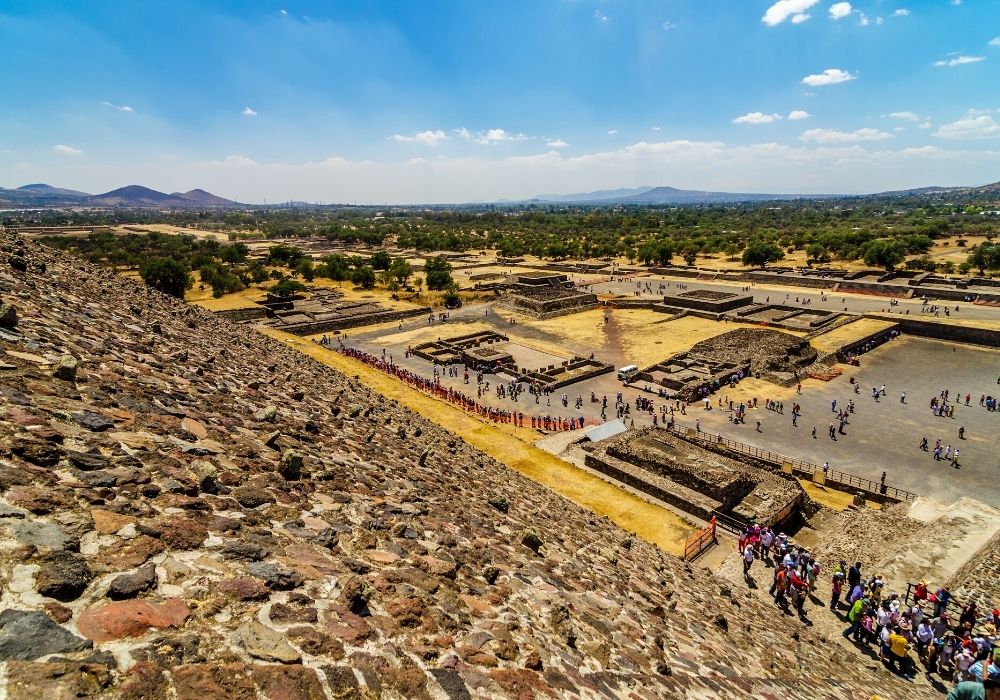
Winter is obviously a little cooler than summer, but in general, you can expect hot but not brutally hot weather for visiting Teotihuacan any time of the year.
There are more rainy days in the summer, although don’t cancel your plans because of rain, but bring an umbrella or raincoat and be extra careful when climbing the pyramids.
So, the main consideration about when to visit Teotihuacan is the crowds. Although there’s plenty of space on the Street of the Dead and the surrounding temple complexes, long lines may form for climbing the pyramids, especially the Pyramid of the Sun.
Teotihuacan gets much more crowded on weekends, particularly on Sunday when it’s free for citizens and permanent residents of Mexico.
Also, avoid visiting Teotihuacan during peak travel season and Mexican holidays. Many Mexicans travel from December to early January (particularly between Christmas and the New Year) and from late July to early August.
Another busy day is on the spring equinox, when many shamans and spiritually minded people visit to perform ceremonies.
And absolutely avoid visiting Teotihuacan during Semana Santa (Holy Week), the week before Easter. It will be extremely crowded every day.
Entrance Fee for the Teotihuacan Ruins
The price for visiting Teotihuacan is 80 pesos ($4 USD) and there’s an additional fee of 45 pesos if you bring video equipment. The ruins are free on Sunday for Mexican citizens and permanent residents of Mexico.
Parking at the Teotihuacan ruins costs 45 pesos.
Conclusion
Visiting Teotihuacan is undoubtedly one of the top things to do in Mexico City. It could almost be considered a right of passage for first-time visitors to Mexico.
In fact, by searching online, you’ll find photos of all kinds of famous people at the ruins, including David Bowie, the Doors, Metallica, and every famous Mexican and Latin American artist you can imagine.
Hey, if it was good enough for Jim Morrison, James Hetfield, and Frida Kahlo, it’ll definitely be good enough for you.
Climbing the Teotihuacan pyramids is fun, the view is magnificent, and once on top, you’ll surely be overcome by the same questions posed by the Aztecs more than 800 years ago. Who built these pyramids? And why?
The post Visiting Teotihuacan, Mexico: A Guide to The Ruins appeared first on Goats On The Road.
![]()




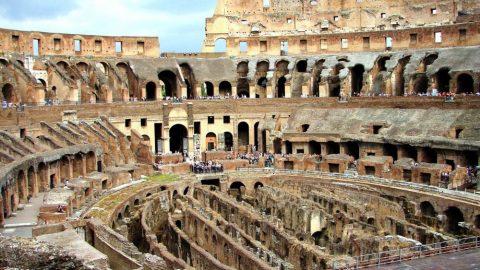
Recent Comments